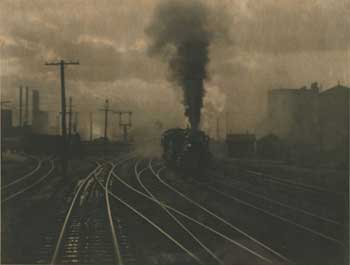
Fin-de-Siècle Europhile Painting
American Tonalism at Spanierman Gallery
By Maureen Mullarkey
AS SUPPLIES OF OLDER ART DIMINISH, dependence grows on marketable categories, on the discovery of movements and factions within them. Scholars are hired to secure territory and mind the borders. So isms proliferate backward in time to cover everything cured in attics and inventories. This magnifies transient tendencies, making movements seem more consequential than the art that comprises them.
 |
| Birge Harrison, Soaring Clouds |
On show at Spanierman Gallery is an absorbing, diverse collection of American paintings and photographs marshaled under the banner of Tonalism. Practiced from the 1880's to the early 1900's, Tonalism was less a coherent movement than a shared sensibility among Euro-savvy American artists. It was a loose, brief convergence of styles that did not even acquire a name until the 1890s. (And barely appears in textbooks.) There are many fine surprises here, most of them by artists who are not household names. Familiar artists—George Inness, J. Alden Weir, John Henry Twachtman, among others—are represented with care.
Tonalism drew from two European springs: the French Barbizon School, by way of its American disciples (Inness and his followers) and Aestheticism, exemplified by the subdued color harmonies and nocturnes of American expatriate James Abbott McNeill Whistler. Tonalists tended to follow one style or the other, often combining features of both. A simultaneous strain of Symbolism ran alongside. You can not avoid wondering if Tonalist claims to being an American phenomenon lie mainly in its mongrel character.
Landscape was the Tonalists’s forte, executed in limited color scales and delicate modulations of light. It favored the evocative power of diffuse, painterly application over factual description, and resisted the brighter palette of its Impressionist contemporaries. While a few figure paintings appear here, the dominant motif is necessarily landscape, the genre most intimately associated—even now—with concepts of beauty.
One of many fascinations in this show is the extent to which Whistler, a European by every measure but birth, informed the momentum of American modernity. By seeing his impact on American painters and photographers, you come away from this show with a heightened regard for his singularity. His influence is beautifully evident in Hermann Dudley Murphy’s “Nocturne” (1895), painted in Paris while Whistler was the rage. A vespertine hush infuses an almost imageless expanse of water and sky, one melting into the other. Only pin points of light—from a tanker? from the opposite shoreline?—pierce the gloaming to evoke an observed setting.
Henry Prellwitz’s “Moonlight Ring” (c. 1910s -1920s) is a splendid nocturne that captures a lunar corona against a night time sky in a manner that stops just short of pure abstraction. Only the fretted edges of an encircling dark, indicating tree tops, ground the image in nature. This minimalist study of light and atmosphere owes its character to the artist’s years in Paris in the late 1890s during Whistler’s reign; but it marked Prellwitz’s distinct response to the landscape of Peconic Bay 10 to 20 years later. Untypical of his earlier narrative work, it underscores the problems inherent in consigning artists to niches.
Charles Rollo Peters studied in the 1880s at the École des Beaux-Arts under Gérome. His “Sand Dunes, Monterey” (1901) is a captivating distillation of those tensions between nineteenth century academicism and modern motives that Tonalism straddles. Forms are flattened by nocturnal shadow and tracks of carriage wheels in the sand trace an abstract pattern between moonlit dunes. The structure of it anticipates Milton Avery’s seaside canvases with startling prescience.
 |
| Alfred Steiglitz, The Hand of Man |
Find Whistler’s own pellucid “Seascape” (1883), a watercolor delicately mottled and accented by shifting silvery blues above and below a thread of horizon. Then look at Leon Dabo’s ghostly “Hudson River” (1918), a mannered and monotonous imitation of Whistler’s tonal harmony. Comparison illustrates the danger of assigning significance to individual works on the basis of association. (Dabo’s signed his work with a Whistlerian monogram.)
You will want to see more of Charles Warren Eaton, Birge Harrison, Arthur Hoeber, J. Francis Murphy and Henry Ward Ranger after this. No ideologue about painting protocols, Harrison’s complex paint surfaces and tonal range display great sympathy with Impressionist aims. Of the four paintings on view, each is coloristically distinct, unified by his own evident love of the the veiled and half seen. Arthur Hoeber’s two paintings—a low-lying marsh and a meadow beneath broad expanses of jewel-toned sky—validate critical reception of them in his day as “refined, intimate and poetic.” Distinguished in his lifetime, Henry Ward Ranger deserves a current audience. His complex paint surfaces, beguiling transparencies and Barbizon sympathies are represented here. (It would be interesting to compare these to his lively depictions of boats in New England harbors, images which escape the brackets of Tonalism.) Included in the show are 27 prints (mainly platinum) and photogravures by 11 inter-related early masters of photography: Edward Steichen, Alfred Stieglitz, Clarence White, Imogen Cunningham, Gertrude Kasebier, Alvin Langdon Coburn and others. Selections gravitate around the Photo-Secession group and Steiglitz’s “Camera Works,” his fine art photography magazine. Emphasis is on landscape rendered in soft-focus techniques that approximate Aestheticism’s impact on painting. At the time, the aesthetic promise of photography was located in its ability to recreate the authority —and effects—of painting.
Steiglitz’s “The Hand of Man” (1902) is reason enough to visit. A locomotive steams out of a train yard, a darksome mechanical power at one with its diaphanous exhaust of black smoke. As a dynamic symbol of man’s initiative in his world, the railroad has bowed to missiles, space technology and every devouring gift of our own modernity. There is a piquancy to this image that exceeds anything Steiglitz intended.




“The Poetic Vision: American Tonalism” at Spanierman Gallery (45 East 58th Street, 212-832-0208).
This review first appeared in The New York Sun, December 15, 2005.
Copyright 2005, Maureen Mullarkey







